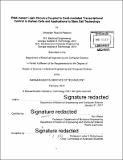| dc.contributor.advisor | Ron Weiss. | en_US |
| dc.contributor.author | Palacios, Sebastian Ricardo | en_US |
| dc.contributor.other | Massachusetts Institute of Technology. Department of Electrical Engineering and Computer Science. | en_US |
| dc.date.accessioned | 2017-05-11T19:59:00Z | |
| dc.date.available | 2017-05-11T19:59:00Z | |
| dc.date.copyright | 2017 | en_US |
| dc.date.issued | 2017 | en_US |
| dc.identifier.uri | http://hdl.handle.net/1721.1/108981 | |
| dc.description | Thesis: S.M., Massachusetts Institute of Technology, Department of Electrical Engineering and Computer Science, 2017. | en_US |
| dc.description | Cataloged from PDF version of thesis. | en_US |
| dc.description | Includes bibliographical references (pages 37-38). | en_US |
| dc.description.abstract | This work demonstrates fundamental advancements towards the construction of an RNAi-based molecular computing core genetically encoded in the genome of human induced pluripotent stem cells (hiPSCs). This architecture can be theoretically programmed to precisely control stem cell differentiation. First, we use computational biology to analyze differential miRNA expression during human stem cell differentiation and guide biological design. We then design, build, and test proof-of-concept RNAi-based circuits in living human cells and couple them to Cas9-mediated transcriptional control. Finally, we demonstrate stable integration of an RNAi-based sensor in chromosome 19 (AAVS1 locus) of hiPSCs using landing pad technology followed by successful differentiation into brain-like tissue. | en_US |
| dc.description.statementofresponsibility | by Sebastian Ricardo Palacios. | en_US |
| dc.format.extent | 38 pages | en_US |
| dc.language.iso | eng | en_US |
| dc.publisher | Massachusetts Institute of Technology | en_US |
| dc.rights | MIT theses are protected by copyright. They may be viewed, downloaded, or printed from this source but further reproduction or distribution in any format is prohibited without written permission. | en_US |
| dc.rights.uri | http://dspace.mit.edu/handle/1721.1/7582 | en_US |
| dc.subject | Electrical Engineering and Computer Science. | en_US |
| dc.title | RNAi-based logic circuitry coupled to Cas9-mediated transcriptional control in human cells and applications to stem cell technology | en_US |
| dc.title.alternative | Ribonucleic acid interference-based logic circuitry coupled to Clustered Regularly Interspaced Short Palindromic Repeats associated protein 9-mediated transcriptional control in human cells and applications to stem cell technology | en_US |
| dc.type | Thesis | en_US |
| dc.description.degree | S.M. | en_US |
| dc.contributor.department | Massachusetts Institute of Technology. Department of Electrical Engineering and Computer Science | |
| dc.identifier.oclc | 986497452 | en_US |
